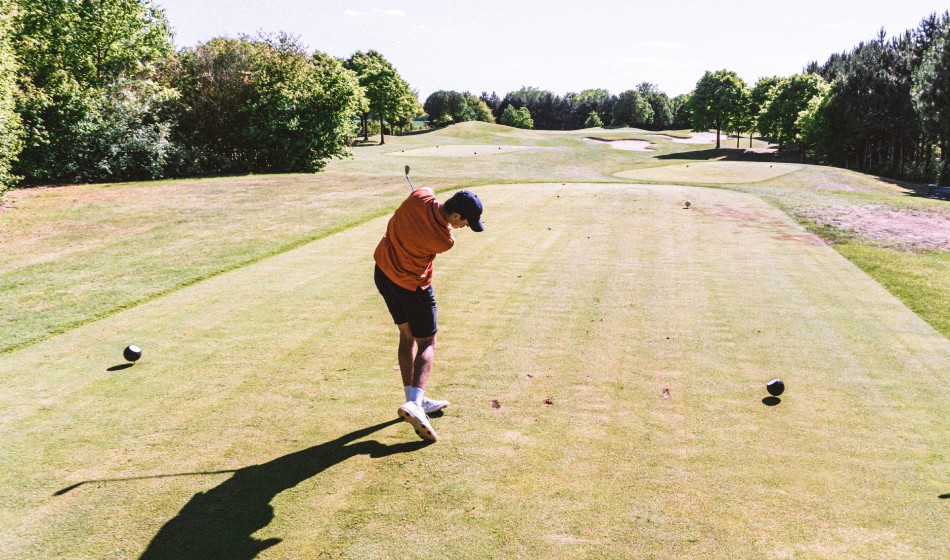
Hip Rotation in the Golf Swing: Mechanics and Fundamentals
17 de February de 2024
Understanding hip rotation is essential for improving our golf swing. It’s the heart of a powerful and controlled movement, making the difference between a mediocre hit and an exceptional one. After all, in golf, the fine details define the great players.
The hip is the foundation of the power tower in our swing. If we move it correctly, we can maximize the distance and accuracy of our shots. But, how do we achieve that perfect rotation we see in professionals? Don’t worry, we’re here to break it down and make it understandable and, above all, applicable.
Whether you’re looking to correct a persistent slice or simply add a few extra meters to your drive, the key might be in how you rotate your hips. Let’s dive into the secrets of an effective swing and how hip rotation can become your best ally on the golf course.
Fundamentals of the golf swing
The golf swing is a precise dance between technique and power. To master it, understanding its fundamentals is essential. We’ll start by exploring the importance of posture and grip, then dive into the heart of the swing: hip rotation.
Posture: The base of an effective swing starts with the correct posture. Your feet should be shoulder-width apart, with a slight bend in the knees. Keep your back straight and your head down, making sure you’re comfortable and balanced.
Grip: A firm yet relaxed grip is crucial. The hands should join on the club forming a ‘V’ with the thumbs pointing downwards. This grip will allow you to control the club through the complete swing.
Hip Rotation: It’s the engine of the swing. Proper rotation generates power and accuracy. When starting the backswing, rotate the hips back, keeping the upper body in tension. In the downswing, the hips lead the movement towards the target, thus releasing the accumulated energy.
Coordination and Flow: The swing is a coordinated and fluid movement. The backswing and downswing should feel like a single continuous movement, where every part of the body contributes harmoniously to the final result.
By mastering these fundamentals, you’ll be on the right path to perfecting your golf swing and enjoying each round with greater confidence and consistency. Remember, practice makes perfect, so let’s get practicing!
Mechanics of pelvic rotation
Pelvic rotation is a key aspect of an effective golf swing. This mechanic involves a coordinated movement that starts from the core, allowing energy to flow from the feet up through the torso and finally to the club. It’s the foundation for generating power and accuracy.
Understanding pelvic rotation is crucial. During the backswing, the pelvis rotates back, away from the target. This action should be smooth and controlled, avoiding abrupt movements that unbalance the body. Stability is essential for effective rotation.
In the moment of the downswing, the pelvis initiates the movement back. The leading hip should rotate towards the target, creating an “unwinding” effect that transfers the accumulated force to the hit. This movement must be synchronized with the rest of the body to maximize the swing’s efficacy.
The correct sequence of rotation is fundamental. Golfers must ensure that the rotation starts from the ground, with a weight transfer that flows naturally through the legs and pelvis before reaching the upper body. If the sequence is incorrect, the hit may lose power and direction.
For an optimal pelvic rotation, maintaining proper posture is important. Flexibility and strength in key areas, such as the abdominal, lower back, and leg muscles, contribute to a more effective rotation and prevent injuries. Practicing specific exercises can significantly improve the mechanics of pelvic rotation in the golf swing.
Remember that practice leads to perfection. Repeating the pelvic rotation movement, with attention to technique, will help you internalize the correct movement and perform it automatically on the golf course. Keep practicing and you’ll see the results in your game!
3 Tricks to improve hip mobility
Hip mobility is key in the golf swing, allowing for a fluid and powerful movement. Improving this mobility will not only increase the distance of your shots but also reduce the risk of injuries. Here are three effective tricks:
- Hip rotation exercises: Start by performing exercises that promote internal and external hip rotation. You can do this sitting on a chair, rotating the hips to both sides with a straight back. Consistency is key; practice these movements daily.
- Dynamic stretches: Incorporate dynamic stretches before each practice or round of golf. Lateral lunges are perfect for this purpose. They not only prepare your hips for the movement but also activate the muscles you’ll use during the swing.
- Yoga or Pilates: These disciplines are excellent for improving overall flexibility and mobility. Specific asanas or Pilates postures work directly on hip mobility, strengthening and providing a wider range of motion.
Implement these tricks into your routine and watch how your golf swing improves significantly. Remember that patience and perseverance are your allies on the path to optimal hip mobility.
Want to learn more about how to improve hip rotation? Discover how with these 7 exercises to improve hip rotation.
Advanced hip rotation techniques in professional golfers
Hip rotation is crucial for a powerful and accurate golf swing. Professional golfers perfect this technique to maximize distance and control. Let’s look at some advanced techniques they use.
Rhythm control
The key is in the timing. A too-fast hip turn can trigger a domino effect of errors. Professionals practice a steady rhythm, ensuring that the rotation complements the movement of the arms and the club.
Flexibility and strength
An effective hip turn depends on the flexibility and strength of the torso. Professional golfers include specific exercises in their routines to strengthen and make the lumbar region and hips more flexible, thus improving the amplitude and power of the turn.
The Downswing sequence
The timing of the downswing initiation is critical. Advanced golfers start the movement from the ground, using the strength of their legs to begin the hip rotation before the arms and club descend.
Stability of the lead foot
Keeping the lead foot firmly planted on the ground during the downswing helps create a solid base for hip rotation. This facilitates a more efficient energy transfer to the swing.
Implementing these advanced techniques requires practice and dedication. However, the result is a more powerful and controlled swing that can take your game to the next level. Integrate them into your training and observe the difference on the field!
Hip rotation is a key component in achieving a powerful and accurate golf swing. Practicing the correct technique not only improves your game but also helps prevent injuries. Remember, consistency is your ally; practice regularly so that each movement becomes second nature.
To take your game to the next level, focus on fluidity and balance. Integrate specific exercises into your training routine that strengthen the muscles involved in hip rotation. And don’t forget that flexibility is as important as strength, so include stretches that improve your range of motion.
Don’t underestimate the power of good instruction. An experienced coach can offer you valuable feedback and custom adjustments to your technique. With patience, practice, and the right guidance, you’ll notice a significant improvement in your swing and, most importantly, in your results on the field. Go for that perfect swing!
